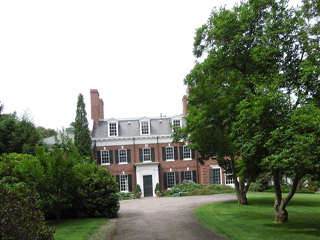
Visited on July 12th, 2013 (Photo credits: Deborah McMillin)
A country brick manor with a formal parterre garden, woodland trails, open fields and a working farm is an estate of the early 20th century but still relevant in the 21st century.
An invitation to a July wedding in Canton, Massachusetts was the impetus for a trip to the Boston area. My internet search of area gardens had found the Eleanor Cabot Bradley Estate, which according to the Goggle Map was a short distance from the Homewood Suites Hotel I was staying at for the weekend in Canton. I had Friday afternoon to myself. The bride to be, Sara, and my daughter Cara, dropped me off at the estate on their way to the church to finish decorations for the Saturday wedding. It would be a respite from a morning that started before a 6:00 a.m. flight out of Norfolk, Virginia to Boston.
In the late 1800’s, a prominent Boston surgeon, Dr. Arthur Tracy Cabot inherited family property, a 90- acre farmstead with fertile land in the rolling hills, known as Cherry Hill. In 1902 he retained Charles Platt, who at that time was one of the foremost architects of the Country House movement in the States, to design a Georgian country summer home and landscape the grounds. Platt’s philosophy was to view and design the house and grounds as a unit with buildings and gardens relating to each other. He often planned careful views from buildings to specific landscape features and vice versa. He had traveled to Italy with his brother in 1892 to tour gardens and the Italian Villa concept, which promoted the house and gardens as a single entity appealed to him.
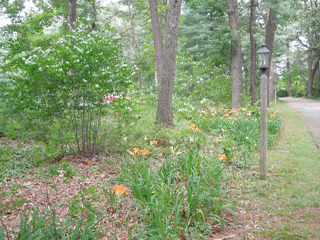
What was rural farm country, originally named Ponkapoag when settled by English colonist in the 1600’s, changed radically in the late 1950’s. Due to vacationing Boston traffic congestion to and from Cape Cod, a new route was needed. Originally the new highway was headed for the front door of the Bradley manor. The large landowners in the area were able to apply pressure for a change in the route and the estate remained intact. The new highway did remove the homes and farms of smaller landlords, permanently changing the rural life of the area with commercial and suburban sprawl from Canton. Route 128 is now a heavily traveled, fast moving two- lane highway, which makes it easy to miss the turn in to the estate, as we did. Once you do turn into the drive, the groves of trees surrounding the parking area buffer the high-speed traffic noise. Even the Llamas grazing in a paddock near the highway and a brood of farm hens appeared oblivious to the repetitive whirl of tires thudding on the pavement nearby.
It was a short walk and the din of the fast lanes was obliterated. Daylilies, with the minimum amount of sunlight to bloom, boarded a narrow shady asphalt road. The sparse woodlands transitioned to an expansive manicured lawn. At the end of the country drive was the stately brick country manor originally situated to provide a view of the Blue Hills and the Neponset River Valley.
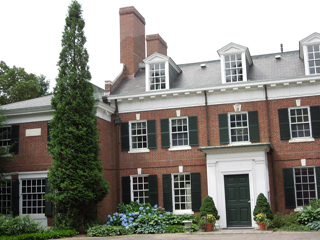
Potted topiary and blue blooming hydrangeas surrounded by several varieties of hosta, were arranged on each side of the front entrance. The home is no longer used for family living; available only when the formal garden is rented for weddings or other private functions. The 90 acres of gardens, woodlands, pastures and farmland is open and free to the general public, which during my visit included several joggers and dog walkers on the woodland trail.
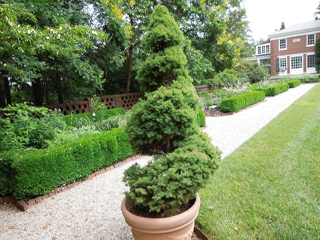
The parterre garden at rear of the manor was the centerpiece of the estate. Still maintained is the latticed- brick walled Italian garden designed by Charles Platt over a century ago. Trees lined the outside of the low brick wall providing shade for hosta and hydrangea. Within the enclosed space of the walls was Italian formality; clipped box hedges, a wide- open lawn outlined with a gravel pathway ands perennial beds mirrored on each side with a water features and sculpture.
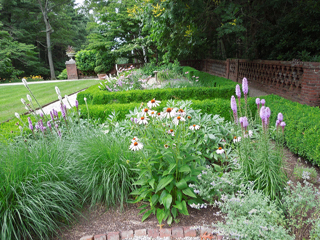
The formal parterre garden is planted in the spring with early bulbs and peony and in the summer annuals for accent color and numerous perennials. I noticed that the majority of the perennials in the July garden were drought tolerant plants. The individual beds were flush with native Echinacea purpurea and Liatris spicata with violet or white flower heads.
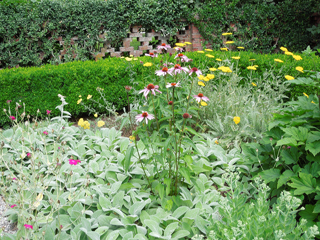
Durable yarrow with yellow flower clusters gave a burst of color above the silvery fuzzy thick foliage of Stachys byzantina, or affectionately known as Lamb’s Ear. A few clumps of white phlox were scattered in the mix. Purple petunias filled in as an annual groundcover. In a shady corner of the garden was an Oak Leaf Hydrangea in full bloom with large white erect flower heads. Sedum and Ligularia would follow in August.
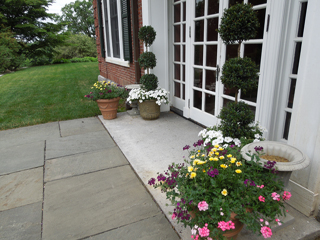
A formal arrangement of annuals and topiary in classic pots stood by the back door of the manor. Peony for spring color, coral bell and Russian Sage (Perovskia atriplicfolia) with airy spires of small blue purple summer flowers was planted against the gray stonewall bordering the steps leading into the formal garden. From here the open view draws you past the brick pillars that define the end of the formal garden.
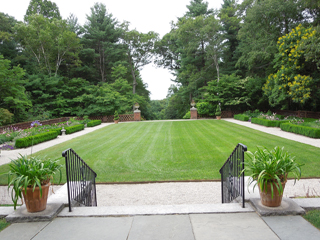
The manicured lawn extended in a seamless extension beyond the brick pillars to provide a view towards the hills of the Neponset River Valley, as part of Charles Platt’s design. Past the pillars a naturalistic landscape had been planted with daylilies in dozens of colors. Bordering trees formed a walkway on each side of the lawn. A Classical sculpture with Rhododendron as a backdrop and daylilies at the base continued the theme of sculpture in the garden.
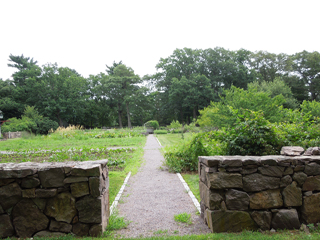
It was to late in the season to see the azaleas and masses of Rhododendron in bloom. I took a level woodland pathway marked for a Rhododendron walk that would lead to the kitchen garden. Surprisingly a few of the massive Rhododendron bushes growing between the pine trees and large rocks were in bloom. The shaded pathway ended at the entrance to a large clearing, a walled vegetable and orchard garden enclosed by a New England dry stonewall.
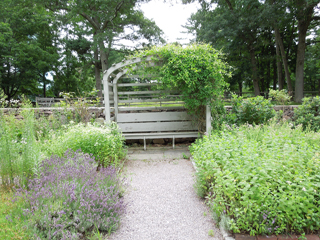
Buddleia bushes laden with purple blooms draped over the grey stonewall that defined the kitchen garden space. The berry crops grown here were raspberries and blackberries, not yet ripe, and strawberries already picked. A large patch of rhubarb was ready for pie. Lavender, covered with bees, Echinacea, and basil grew along side a gravel pathway that led to an arbor covering a bench. The vegetable garden maintained by the young people of the City Harvest Youth Corps was meticulously planted and free of weeds. Apple, pear and apricot trees comprised a small fruit orchard.
A cart path crosses the property and provided an easy hike through the slightly sloping natural terrain of the woods. Large stones and boulders lay loosely stacked, separating trees from pastureland before the dense woods took over the property. It was an appropriate place for the bluebird boxes. As the trees grew denser, the woodland slopes were covered with ferns.
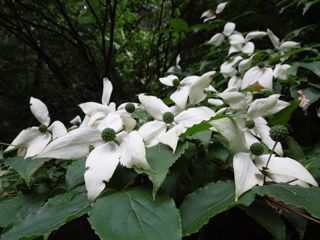
Near a man made pond, the Asian Cornus kuosa dogwood trees were laden with white petal-like bracts. Shag bark hickory trees that provide nuts for the deer, squirrels and the chipmunks I occasionally saw scampering across boulders, were a part of the forest. Cedar trees, mulberry, native sweet gum, and white pines grew on the hillsides. Once thought to be extinct, the ancient conifer from China, Dawn redwood (Metasequoia glyptostroboides), and the Japanese Umbrella Pine that Eleanor Cabot Bradley planted, reflecting her interest in Asian flora, grow in these woods.
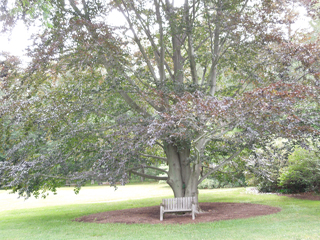
Dr. Arthur Tracy Cabot died in November 1912 and his wife Susan retained ownership of the summer estate for another 30 years. After her death, Dr. Cabot’s niece, Eleanor Cabot Bradley and her husband Ralph acquired the estate in 1945 for their residence. They restored the overgrown fields, added ponds, specimen trees, a greenhouse and a camellia house to over winter those plants tender to the New England winters. Significantly they continued to maintain the formal Italian garden as well as other original plantings.
Eleanor was a friend of the Arnold Arboretum of Harvard University. In 1985 an extensive collection of rose-family plants was created through her gift at the arboretum. Roses that were grown in her garden were also included in the collection, named in her honor and as benefactor, the Eleanor Cabot Bradley Rosaceous Collection. Currently, there is no longer a rose garden at the Bradley Estate.
Upon Eleanor’s death in 1990, the estate was bequeathed to The Trustees of Reservation, a non- profit organization founded in 1891, to preserve land for public use and enjoyment as well as protecting properties of scenic, historic and ecological value in Massachusetts. The organization also owns and manages working farms in the state as a part of their mission to preserve small farms that are rapidly disappearing. They support the growing movement of consumers asking questions – where does their food comes from, how was it grown and what was the carbon footprint to reach the marketplace?
To foster the growth of the “eat local and fresh” movement, the Trustees created a City Harvest Youth program, with the Bradley Estate recently joining as a participant. Fresh produce is grown for inner city farmers markets while teaching young city people the importance of agriculture, health through food, and leadership.
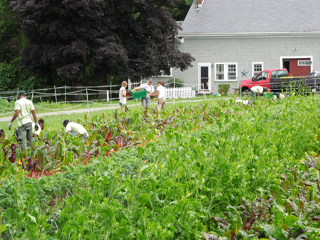
On the day of my visit a group of youths from the Boston urban communities were working in the 15-acre farm field. When I talked to one of the teenagers, Justin from Dorchester, he told me that they work the field once it is planted by weeding, hoeing, harvesting. They sell on Thursday’s at Dorchester non-profit market run by the Bowdoin Community Health Center, and Saturdays at Mattapan Farmers Market, providing fresh produce to areas that do not have the benefit of fresh local foods. It was his first summer working for the program. He said he enjoyed the experience of working in the garden and being surrounded by that environment, which the estate was made to protect and provide an appreciation of nature.
Overall, the farms follow the National Organic Standards growing approximately 40-50 different vegetables. As I walked along the edge of the Bradley Estate field, I found chive, basil, curly and flat leaf parsley planted along with green beans. My husband would be envious of the dozen rows of staked tomato plants. Lettuce, kale, and Swiss chard were grown for greens. Carrots, onions, green and pole beans, sweet peas, with butternut and acorn squash vines covered the fertile, rocky ground.
Dr. Arthur Tracy Cabot’s early 20th century manor is representative of a time when the affluent would build country estates outside of crowded, polluted, industrialized cities as a retreat. Currently the estate has found a place in this century for the public to take pleasure in the gardens, the solitude of the woods and the farmland that provides food to nearby communities. Due to the foresight of Eleanor Cabot Brady, the estate in the 21st century is now protected from any unwelcome intrusions in perpetuity.
Visit this garden at: http://www.thetrustees.org/